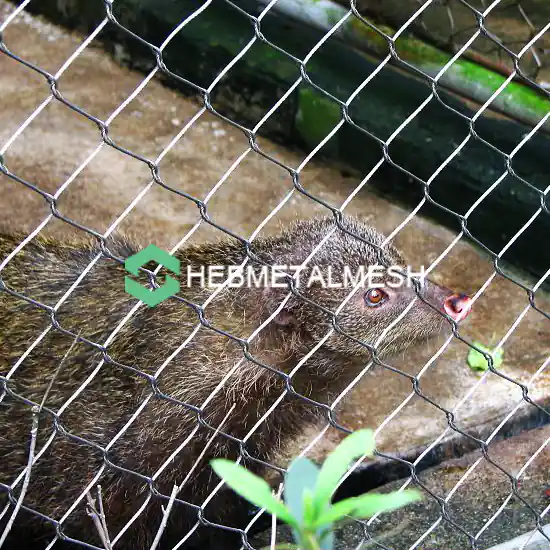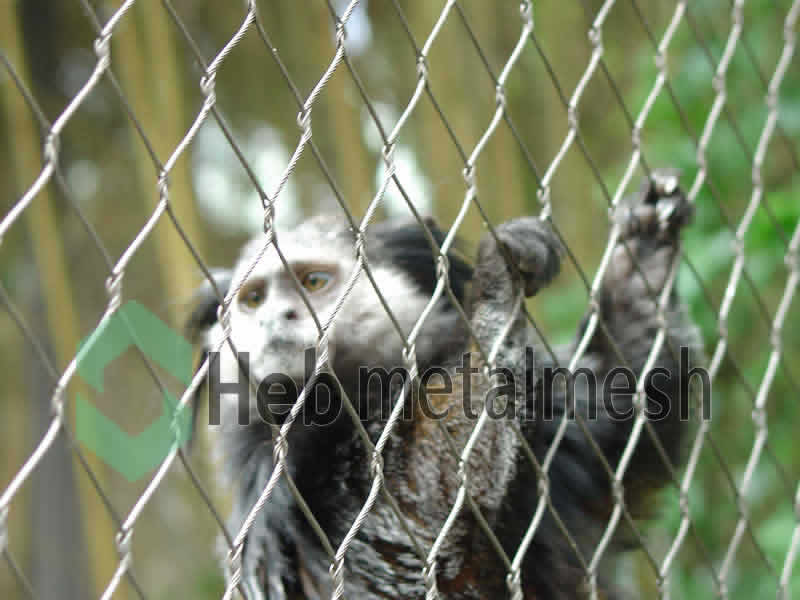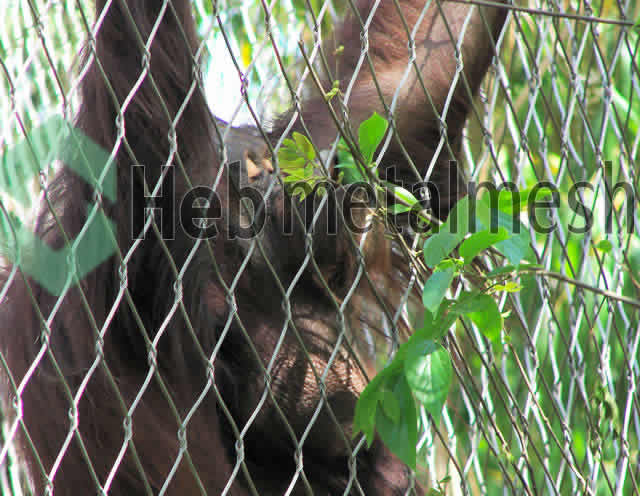Introduction to Zoo Fencing
Zoo fencing serves a crucial role in the operation of modern zoological facilities, providing a safe environment for both animals and visitors. As zoos continue to evolve, ensuring the welfare of animals while enhancing the experience for visitors has become increasingly important. The type of fencing used in zoos must effectively contain various species while allowing for optimal visibility and engagement from the public. The design and materials of zoo fencing contribute significantly to the overall ambiance and aesthetic appeal of the facility.
Hebmetalmesh stands out as a leading stainless steel zoo fencing factory, specializing in flexible handwoven stainless steel netting panels and rolls. This innovative fencing solution allows zoos to create secure habitats that are both functional and visually appealing. The use of stainless steel in zoo fencing provides durability and resistance to environmental factors, ensuring that the enclosures remain safe over time. Unlike traditional fencing materials, stainless steel offers a modern and less intrusive method of containment that aligns well with the ethical considerations of animal care and management.
In modern zoos, the needs of animals and visitors are paramount. The design of animal enclosures must take into account the natural behaviors and habitats of the species while ensuring that there are clear sightlines for visitors to observe and enjoy. Furthermore, the aesthetic aspect of zoo fencing cannot be overlooked, as it contributes to the overall theme and setting of the zoo. Transparent fencing solutions, such as those provided by Hebmetalmesh, allow for a seamless integration of naturalistic elements, enhancing the experience for visitors while promoting a sense of security for animals.
Hebmetalmesh: A Trusted Name in Zoo Fencing
Hebmetalmesh has established itself as a prominent player in the zoo fencing industry over the past 30 years. This extensive experience has allowed the company to cultivate a reputation synonymous with quality and reliability. With a focus on delivering superior zoo fencing solutions, Hebmetalmesh has successfully catered to the unique needs of over 100 zoos and bird parks worldwide. Clients consistently commend the company’s commitment to safety and aesthetics, making them a trusted name among zoo managers and wildlife experts.
One of the essential aspects that set Hebmetalmesh apart is the unparalleled quality of materials used in their zoo fencing products. The company employs high-quality (HQ) stainless steel wire rope, known for its durability and resistance to corrosion. This material not only ensures the longevity of the fencing solutions but also enhances the overall safety for both animals and visitors. The robust construction of the fencing designs provides peace of mind to zoo operators, knowing that their enclosures are secure and designed to withstand the elements.
In addition to material quality, product versatility is another hallmark of Hebmetalmesh’s offerings. Customers can choose from various options regarding color and finish, including natural hues and black oxide, allowing fence designs to blend harmoniously with the zoo’s environment. This attention to aesthetics complements the fundamental purpose of zoo fencing, which is to create a safe habitat for wildlife while ensuring an enjoyable experience for visitors. Hebmetalmesh emphasizes that both safety and visuals are paramount considerations, thus striving to meet the highest standards in the industry.
In summary, Hebmetalmesh’s long-standing history, commitment to quality materials, and dedication to aesthetic value make it a leader in the zoo fencing market. This combination of experience and innovation ensures that zoo operators can rely on Hebmetalmesh to provide secure and visually appealing fencing solutions tailored to their unique needs.
AZA Compliance Standards for Predator-Proof Fencing
The Association of Zoos and Aquariums (AZA) establishes comprehensive safety standards that focus on creating secure enclosures for dangerous animals, including big cats. A fundamental aspect of these standards is the implementation of effective zoo fencing systems designed specifically to prevent animal escapes and ensure public safety. Compliance with AZA standards is not merely a regulatory requirement; it is essential for the welfare of the animals and the safety of visitors.
For big cat exhibits, the AZA specifies various requirements crucial for constructing predator-proof fencing. The primary consideration is the physical strength and durability of the fencing materials. These enclosures must be made from robust materials that can withstand the physical capabilities of large felines, which are known to possess powerful strength and agility. Common materials utilized in such applications include heavy-duty steel mesh or other reinforced structures, specifically designed to deter escape attempts.
Additionally, the design of the fencing plays a vital role in compliance. The AZA recommends tall vertical barriers that eliminate any potential climbing opportunity, along with secure underground extensions to prevent digging – a behavior common in many species, including tigers and lions. The spacing between the fencing elements is also critical; it should be of a size that prevents any part of the animal from fitting through. Regular inspections and maintenance are essential practices that ensure the integrity of zoo fencing remains intact over time.
Ultimately, understanding and adhering to AZA compliance standards ensures that zoos provide a safe and enriched environment for both the animals and the visiting public. By following established guidelines for predator-proof fencing, zoos can uphold a higher standard of care and responsibility for their exotic residents.
Custom Fabrication of Stainless Steel Mesh Panels
In the realm of zoo fencing, particularly for primate enclosures and climbing structures, the necessity for custom solutions cannot be overstated. The unique behaviors and needs of primates demand a specialized approach to their enclosures, ensuring that both safety and enrichment are prioritized. Custom-fabricated stainless steel mesh panels provide an optimal solution, combining durability, flexibility, and an aesthetic appeal that enhances the overall environment.
Stainless steel mesh is incredibly versatile, allowing for the creation of enclosures that are not only functional but also visually engaging. This material is resistant to corrosion and weathering, ensuring long-term reliability in an outdoor setting. Moreover, the custom fabrication process allows for tailored sizing and configuration, accommodating the specific requirements of various species. For instance, different primate species may need varying degrees of climbing opportunities and space, necessitating a personalized approach to fence design.
One significant advantage of utilizing custom stainless steel mesh is its ability to provide enrichment through climbing structures. These features cater to the natural instincts of primates, encouraging exercise and exploration while simultaneously ensuring their safety. By integrating these climbers within enclosures, zookeepers can create a dynamic environment where animals can engage physically and mentally, enhancing their overall wellbeing.
Hebmetalmesh specializes in fabricating these tailored solutions, understanding the critical need for secure yet adaptable zoo fencing. By working closely with zoo professionals, they can design panels that meet specific structural requirements and aesthetic preferences. This collaborative approach not only ensures safety for the animals and staff but also contributes to a visually appealing environment that resonates with zoo visitors.
Non-Climbable Zoo Perimeter Fencing Options
When designing a zoo’s perimeter fencing, it is paramount to ensure that the materials and structures used not only provide robust security but also maintain the aesthetic appeal of the environment. Non-climbable fencing options are specifically designed to deter both human and animal intrusions while preserving the serene and natural atmosphere characteristic of a zoo. A variety of solutions are available to achieve these goals effectively.
One popular choice for non-climbable fencing is the use of welded wire mesh panels. These panels can feature a variety of hole sizes and configurations, effectively hindering climbing while allowing for visibility. Additionally, welded wire mesh is durable and robust, capable of withstanding the elements and resisting rust, making it an excellent long-term investment for zoo fencing. The vertical orientation of the mesh also inhibits climbing, creating an effective barrier without compromising visibility.
Another option is the installation of angled fencing systems, where the top section of the fence tilts outward at an angle. This ingenious design not only makes it more difficult for animals to escape but also for people to gain unauthorized access. The angle can be tailored to blend seamlessly with the surrounding environment, minimizing visual disruption while maximizing deterrence.
Incorporating natural materials such as timber posts or stone into the design of the fence can further enhance the visual appeal while achieving the necessary security. By using non-toxic treatments for wood, such as stains or sealants, one can ensure that the fence remains safe for animals and visitors alike. Strategically placed plantings can also help in softening the hard edges of perimeter fences, creating a more inviting atmosphere. The key lies in striking a balance between functionality and aesthetics, allowing the zoo to maintain a secure area while providing an enjoyable experience for its visitors.
Comparing Galvanized Steel and Stainless Steel Mesh for Aquatic Bird Habitats
When designing aquatic bird habitats, the choice of materials for zoo fencing is paramount to ensure the safety of the birds and the durability of the installation. Two common options for such applications are galvanized steel and stainless steel mesh. Each material presents unique advantages and disadvantages, particularly in terms of cost, durability, and resistance to the harsh conditions often found in wet environments.
Galvanized steel is a popular choice due to its relatively lower cost compared to stainless steel. The galvanization process involves coating the steel with zinc to protect it from rust and corrosion, making it a viable option for environments with some exposure to moisture. However, in highly humid or wet conditions, galvanized steel may have limitations in longevity, as the protective zinc layer can wear away over time. The maintenance of galvanized fencing is crucial, as any scratches or damages to the coating can lead to rust formation, compromising the integrity of the fence. Therefore, while the initial investment is lower, long-term value can decrease due to potential repairs and replacements.
On the other hand, stainless steel mesh is renowned for its superior resistance to rust and corrosion, making it ideal for aquatic bird habitats. Composed of a higher nickel and chromium content, stainless steel remains resilient in wet environments, significantly extending the life of the fencing. This durability often translates to a higher upfront cost; however, stainless steel’s longevity may prove more cost-effective over time when taking into account maintenance and replacement needs. For institutions aiming to create sustainable and safe habitats, stainless steel zoo fencing can offer peace of mind, knowing that the structural integrity will remain intact even in challenging conditions.
In conclusion, both galvanized steel and stainless steel mesh have their place in constructing aquatic bird habitats. The decision ultimately hinges on evaluating the balance between initial costs, long-term durability, and the specific environmental conditions of the habitat. Understanding these factors is essential for making an informed choice that ensures both safety and aesthetic appeal in zoo fencing.
Integrating Heavy-Duty Wildlife Fencing with Viewing Glass Systems
As modern zoos increasingly prioritize both animal welfare and visitor experience, the integration of heavy-duty wildlife fencing with viewing glass systems has become paramount. Architects and designers face the unique challenge of creating exhibits that not only keep animals secure but also provide an unobstructed view for visitors. This dual focus necessitates careful planning and consideration of both aesthetic and functional elements within the zoo environment.
Heavy-duty wildlife fencing serves as a critical component in ensuring the safety of both animals and visitors. By utilizing robust materials, such as steel mesh or reinforced barriers, designers can provide a reliable physical boundary that effectively contains various species. These fences are particularly vital in habitats with larger or more aggressive animals that require enhanced security measures. In contrast, viewing glass systems allow for a more immersive visitor experience, breaking down the barriers typically associated with traditional enclosures. When strategically integrated, these elements can create a visually appealing and captivating atmosphere that enhances the overall zoo experience.
Moreover, the harmonious integration of zoo fencing and viewing glass systems encourages interactive learning. Visitors can observe animals in a more naturalistic setting without the distractions of traditional barriers. This design approach also supports transparency in animal management practices, fostering a better understanding of wildlife conservation among zoo-goers. Architects must consider factors, such as visibility angles, animal behavior, and maintenance needs, to ensure that these systems function effectively. Engaging with wildlife fencing and the transparent materials of viewing glass can lead to innovative designs that captivate and educate audiences.
In conclusion, the successful integration of heavy-duty wildlife fencing with viewing glass systems is essential for modern zoo designs. By carefully balancing safety, aesthetics, and visitor engagement, architects and designers can cultivate environments that fulfill the dual objectives of protection and interaction, ultimately enriching the zoo experience for all.
Best Practices for Installing Zoo Fencing
The installation of zoo fencing is a critical aspect of maintaining both safety for the animals and an enjoyable experience for visitors. Adhering to best practices can ensure that the fencing system is sturdy, secure, and visually appealing. One of the primary considerations is to conduct a thorough site assessment prior to installation. This process involves evaluating the specific characteristics of the location, including terrain, soil type, and potential environmental challenges. Understanding the site-specific factors is essential in determining the most appropriate type of fencing material, such as chain-link or mesh systems, which are often favored for their strength and durability.
Moreover, it is paramount to ensure compliance with local and national safety standards governing zoo fencing. These regulations often specify minimum heights, barriers against climbing, and visibility for both animals and visitors. Engaging with experts like Hebmetalmesh can streamline this process, given their extensive knowledge in designing fencing solutions that meet and often exceed these safety requirements. Their products are tailored to offer robust protection while also being adaptable to the unique challenges posed by different environments.
Another aspect to consider is the aesthetic integration of the zoo fencing into the overall landscape. Fencing should not only serve a protective function but should also enhance the visual appeal of the exhibits. Utilizing materials that blend with the natural surroundings can facilitate a more immersive experience for visitors, which is essential in zoological environments. Furthermore, employing proper installation techniques, including deep foundations and secure fastenings, will enhance the longevity of the fencing. Regular maintenance checks should be scheduled to ensure that the fencing remains in optimal condition, mitigating any potential safety risks over time.
Conclusion: Why Choose Hebmetalmesh for Zoo Fencing
When it comes to selecting zoo fencing, the significance of quality, durability, and aesthetic appeal cannot be overstated. Hebmetalmesh stands out as a premier choice for zoo professionals seeking reliable fencing solutions. With a strong focus on stainless steel materials, Hebmetalmesh offers products that not only withstand the rigors of outdoor environments but also enhance the overall appearance of animal enclosures. The use of high-grade stainless steel ensures that the fencing is resistant to rust, corrosion, and wear, ultimately extending its lifespan and reducing maintenance costs.
Moreover, Hebmetalmesh is committed to delivering custom solutions tailored to meet the specific needs of each zoo. Understanding that every facility has unique requirements when it comes to animal safety and visitor experience, they work closely with zoo professionals to design fencing that matches dimensions, preferences, and security concerns. This level of customization allows for greater flexibility in design, ensuring that the fencing integrates seamlessly with existing structures and landscapes.
In addition to their exemplary products, Hebmetalmesh adheres to stringent industry standards, which instills confidence in their clientele. Compliance with these standards guarantees that the zoo fencing installed not only meets safety regulations but also supports optimal animal welfare. With expertise built over years in the field, Hebmetalmesh has established itself as a trusted partner for zoos, providing fencing that is both functional and visually appealing.
For those looking to enhance their zoo with the right fencing solution that prioritizes safety, reliability, and beauty, Hebmetalmesh is undoubtedly the ideal choice. Zoo professionals are encouraged to explore the diverse offerings of Hebmetalmesh and discover how their expert solutions can transform the fencing of their facilities.
FAQ: Zoo Fencing
Hebmetalmesh zoo mesh is definitely the best fence to keep wildlife out. as it is strong, durable, and long-lasting. Its small openings prevent predators from entering the enclosure, while also keeping the animals inside safe. The mesh is made from high-quality steel, which is resistant to corrosion and weathering, making it ideal for use in outdoor environments. Additionally, it is easy to install and maintain, making it the perfect choice for wildlife enclosures, animal sanctuaries, and zoos. With its many benefits, hebmetalmesh zoo mesh is definitely the best fence to keep wildlife out.
For both securing animals and keeping them safe from predators. It is strong and durable, and can withstand harsh weather conditions. Additionally, the small openings in the mesh prevent animals from escaping or getting their heads stuck. Overall, hebmetalmesh zoo fencing is a reliable choice for any zoo or animal enclosure.
Stainless steel zoo fencing offers superior strength, corrosion resistance, and longevity, making it a safe and virtually maintenance-free containment solution for a wide range of animal habitats.
Yes. Our heavy-duty stainless steel mesh for predator enclosures is designed to withstand harsh weather and provide secure, reliable containment for even the most powerful animals.
Absolutely. We manufacture custom-cut zoo mesh panels and rolls to meet the exact specifications of your project, ensuring a perfect fit for any animal enclosure design.
The black oxide zoo fencing provides a reduced glare, aesthetically pleasing appearance that blends into natural surroundings while maintaining all the durability of stainless steel.
Our zoo fencing features smooth, robust welds and is made from non-toxic stainless steel, creating a secure animal-safe stainless steel barrier that prevents injury.


